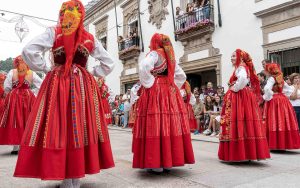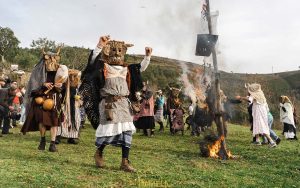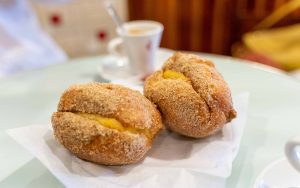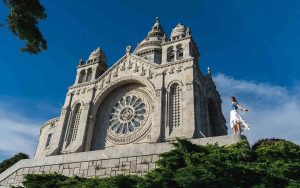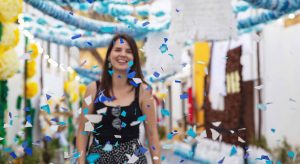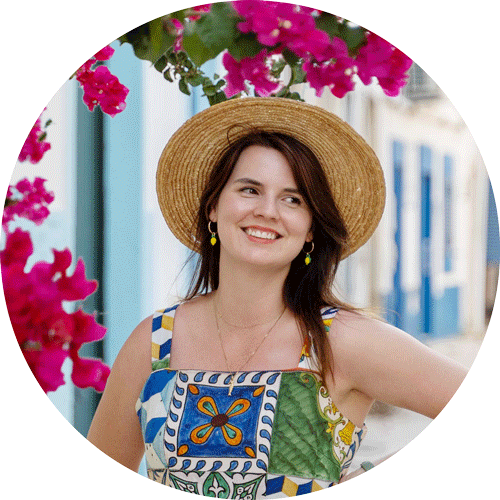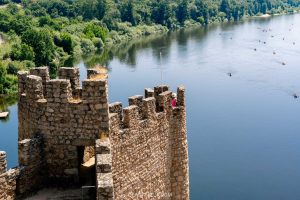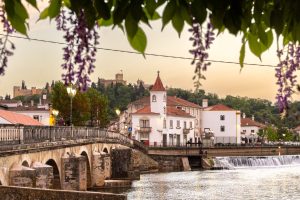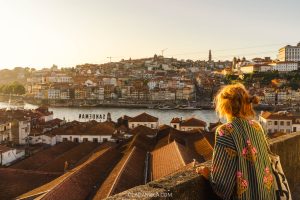One of my favourite experiences in Portugal was witnessing the Mordomia Parade where more than 900 women proudly marched by wearing the ornate traditional costumes from their village. While the poster of the festival of d’Agonia, which falls every August, usually features a beautiful young woman wearing the most famous traditional red dress from Viana do Castelo, there are actually many variations and styles of traditional dress found across the Minho region.
I took so many photos of the parade, and I wanted to find a way to share them with you here. There was a great exhibition at the festival that explained the different traditional costumes and their purpose, so I’ll do my best to share some details here along with photographs.
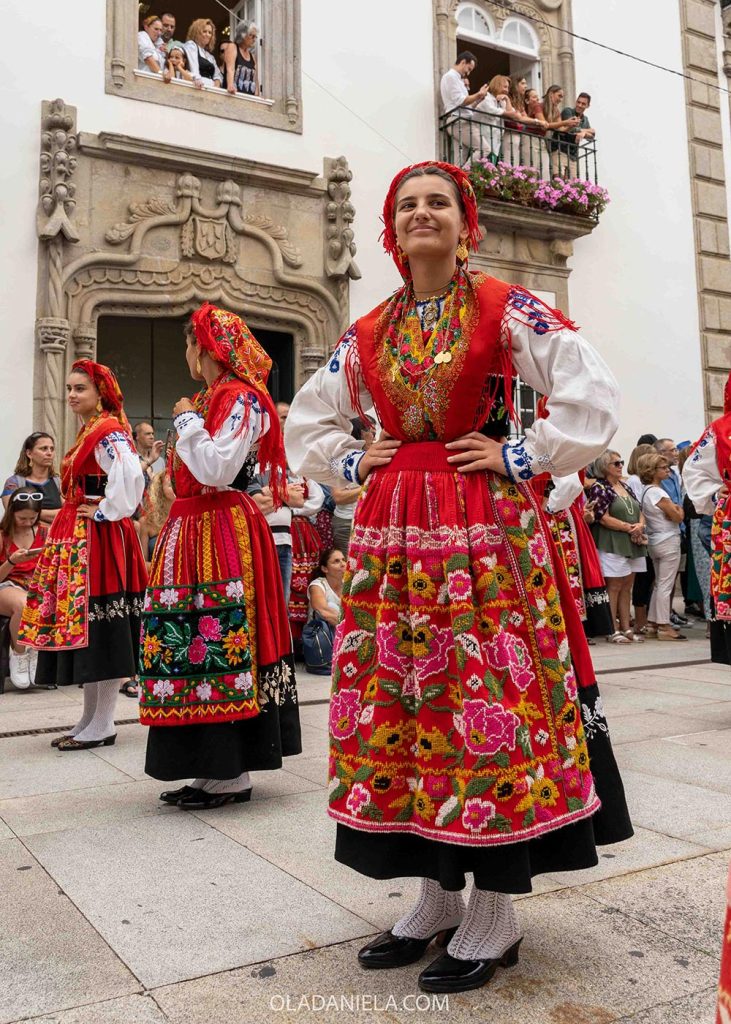
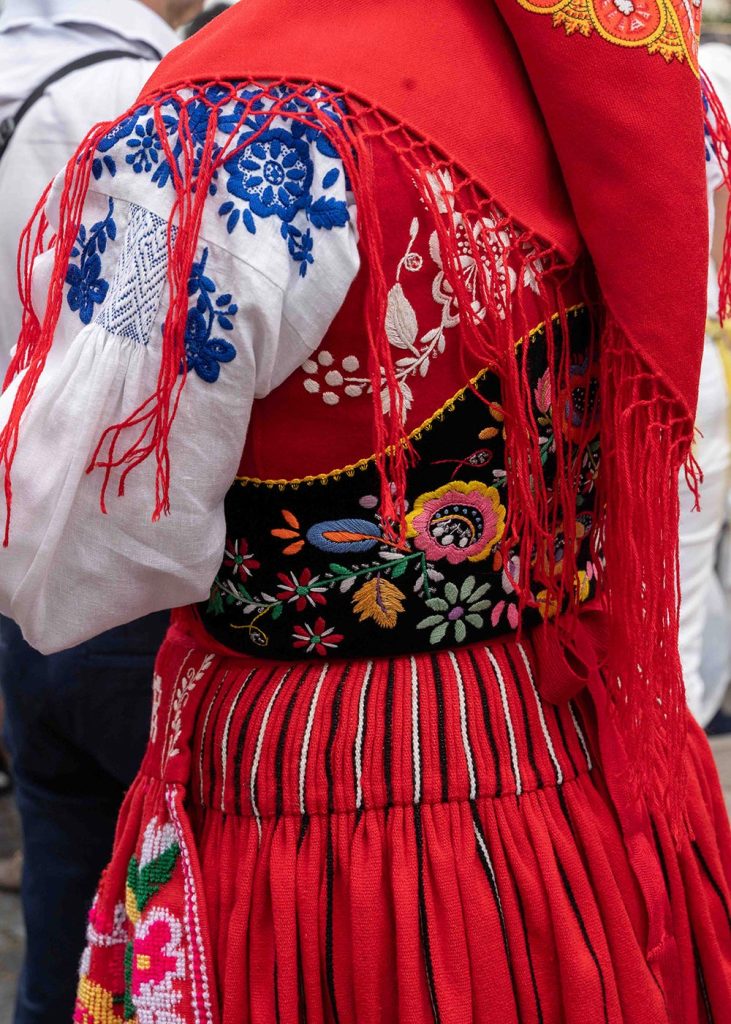
I’m in no way an expert on this matter, so I’ve done my best to relay and translate information from official sources on the subject. If you have more information for me to share, or if I have attributed something incorrectly – please let me know.
Contents
ToggleTwo ways to see traditional costumes if you visit Viana do Castelo
The first is simple. Visit the Museum do Traje or Costume Museum in Viana do Castelo. Houses in a grand 1950s building that was once a bank, the museum opened in 1997 and displays a great range of traditional dress for both men and women. It’s only a couple of euros to get in, and I go every time I’m in Viana. A must visit!
Read next: 15 best things to do in Viana do Castelo
The other way to visit in August during the incredible Romaria de Nossa Senhora d’Agonia when there is a program of events that brings women out onto the streets in their beautiful hand-made outfits. There are a few parades, folk dancing, and more that means you’ll see women in their “Sunday best” traditional dress across the nine-day event.
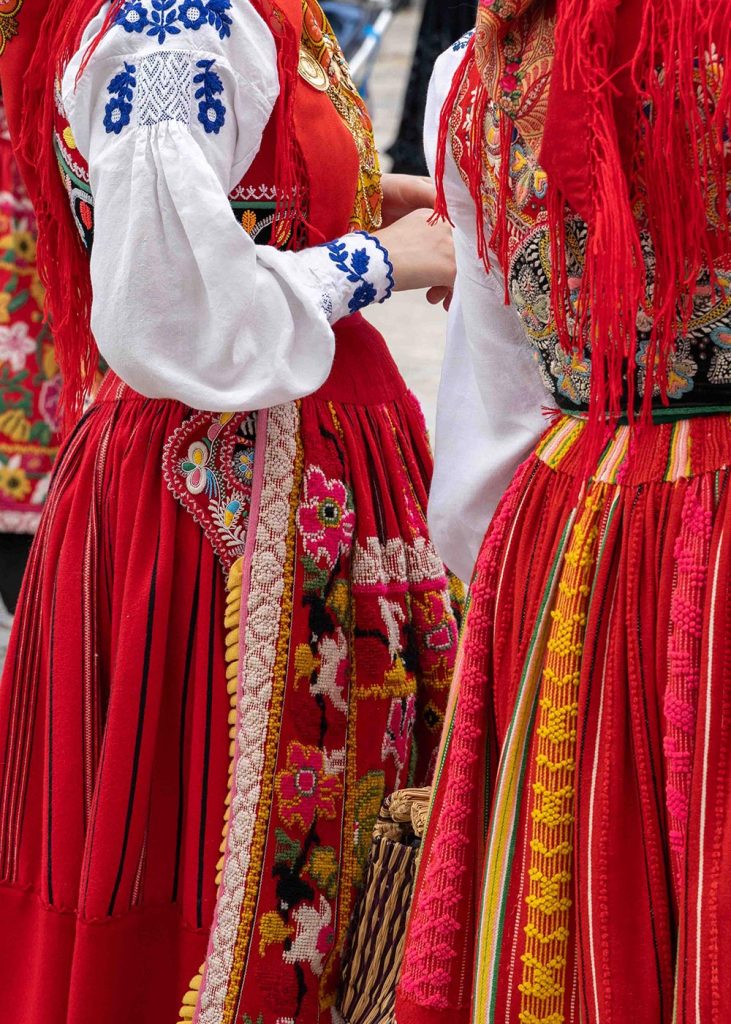
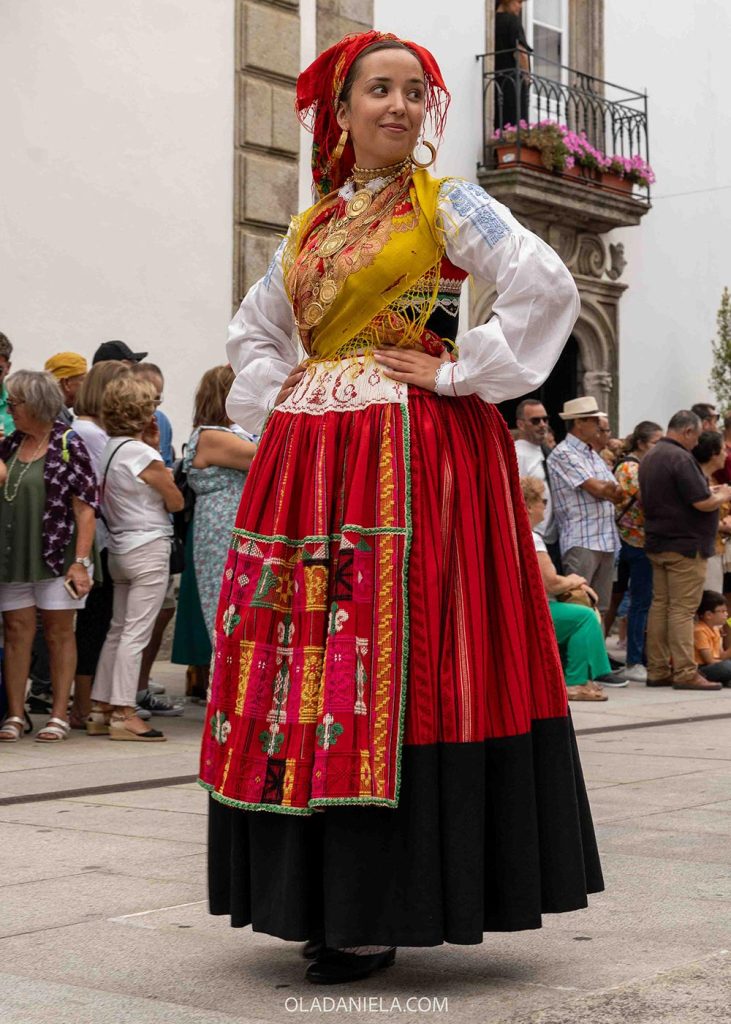
Traditional costumes of Minho (Trajes do Minho)
Trajes de Festa de Ribeira – Viana do Castelo’s Fisherman’s Quarter Costume
The traditional Minho costume least like the other traje was from Viana do Castelo. Women from Ribeira, the fisherman’s quarter of the town, paraded down the street in what seemed like shorter, cotton fabrics (not wool or linen). They wore shorter checked skirts with aprons, whose details were “Richelieu” cut-outs fined carved into the fabric. Overall the look was more basic and they have shorter skirts with no socks, which may reflect the fact they would work by the sea or at the docks getting wet.

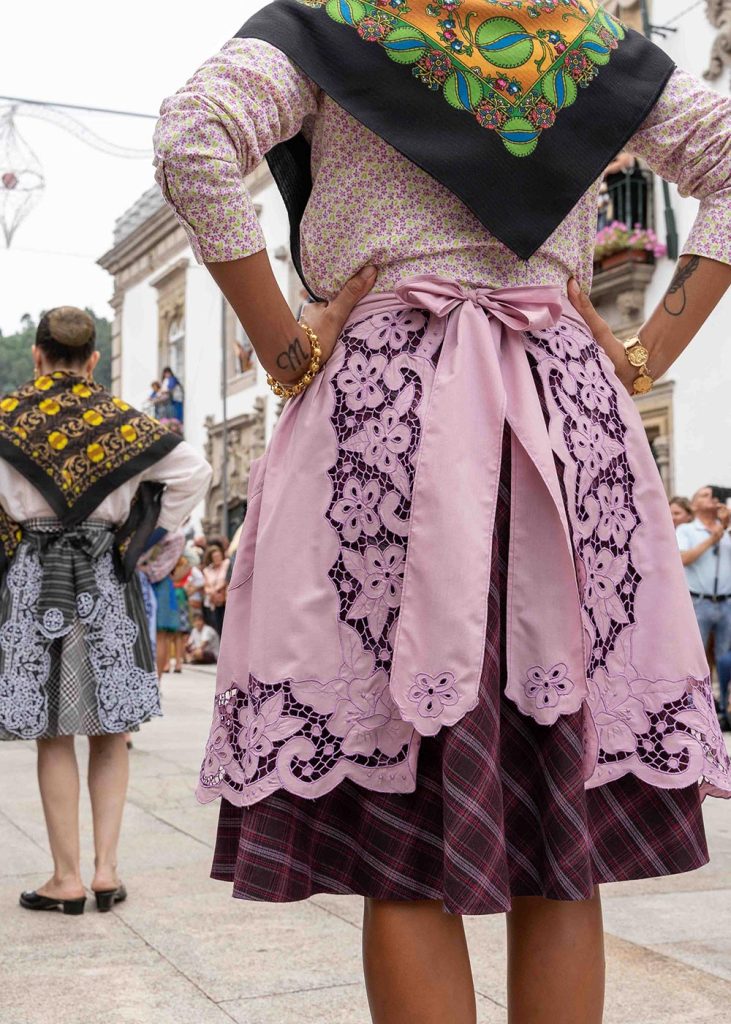
Trajes de Lavradeira – Farmer’s Costume
The famous red Portuguese costumes were used by farmers on Sundays or when they went to the Friday market in Viana do Castelo to sell produce. These costumes were used between the late 19th century and mid 20th century by agricultural families in this fairly self-sufficient region.
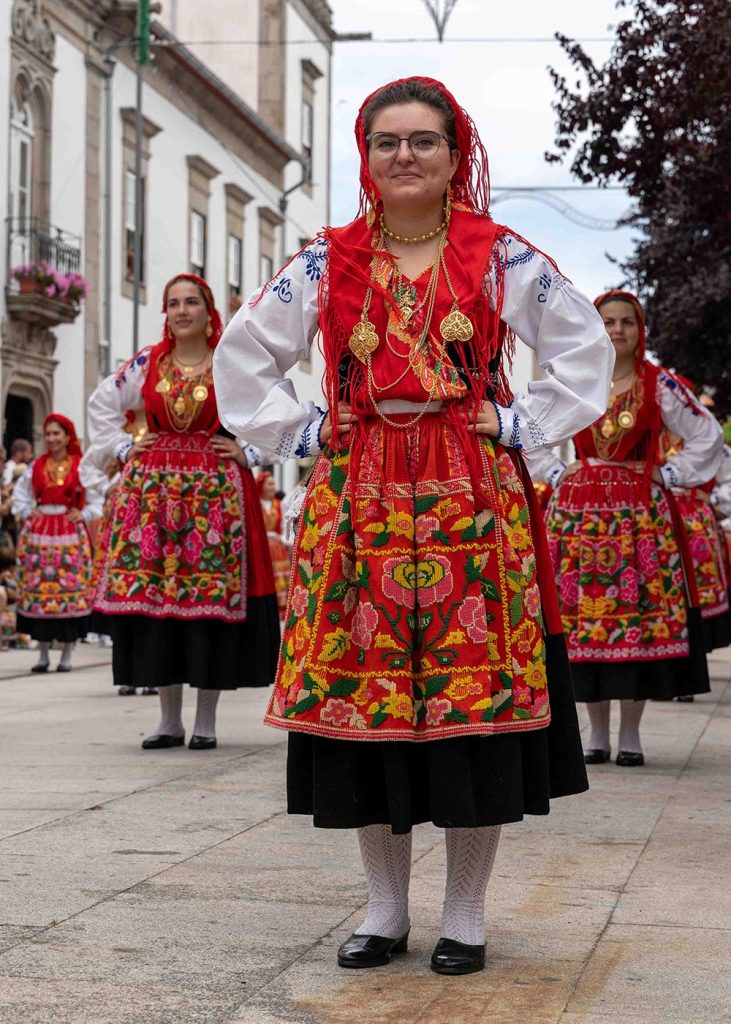
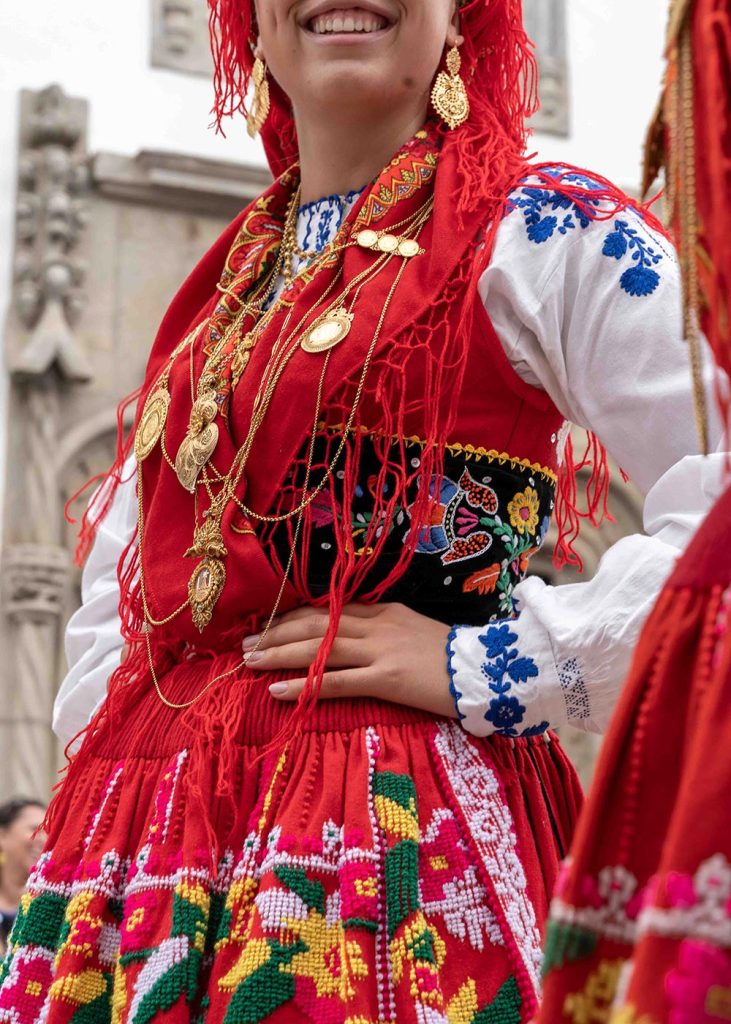
The lavradeira costumes generally included:
- An apron (avental) – adorned with embroidered floral motifs and leaves
- Scarves (lenços) – colourful scarves often draped over the shoulders and head
- A vest (colete) – a cropped vest that is often a work of art, embroidered with ornate floral scenes and folkloric motifs.
- A pocket (algibeira) – an external pocket on a long strong that would be tied around the waist. This is often the shape of a heart with very detailed embroidery and beads.
- Slippers (chinelas) – slip-on hand-made black clogs sometimes with embroidery, worn with cotton socks.
- Gold jewellery – heirloom pieces gifted to the women or passed down through the family. I’ll touch more on the gold pieces at the bottom.
Below I’ll mostly share some pictures, but I’ll also highlight some small differences (where possible!) in the lavradeira (farmer) costumes from different villages or towns.
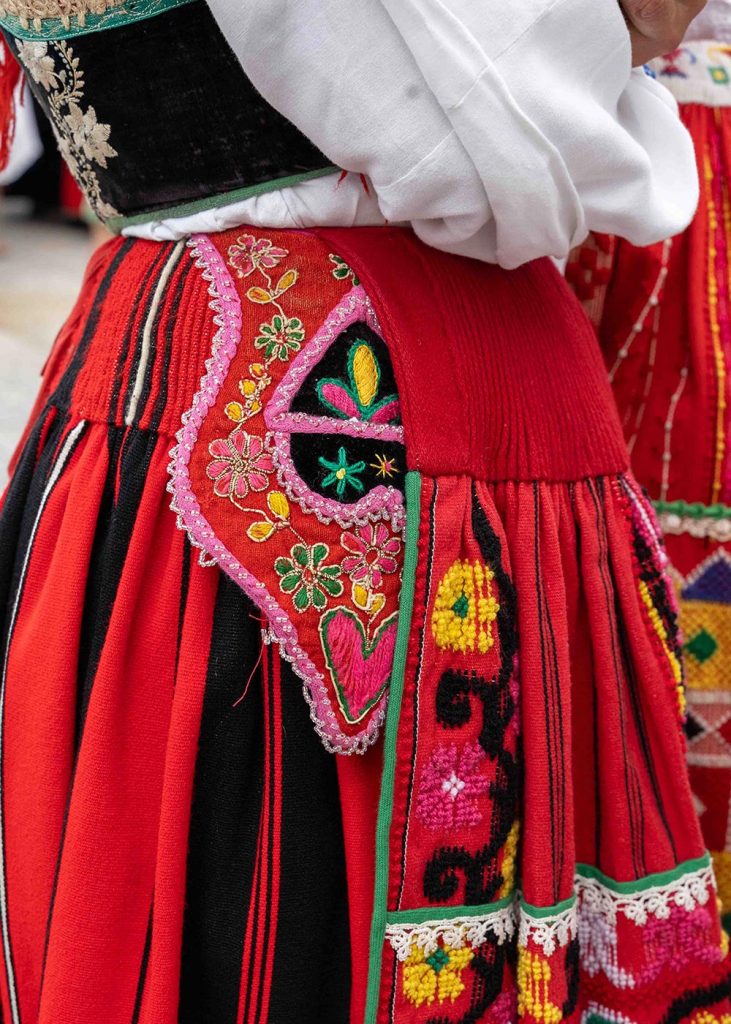
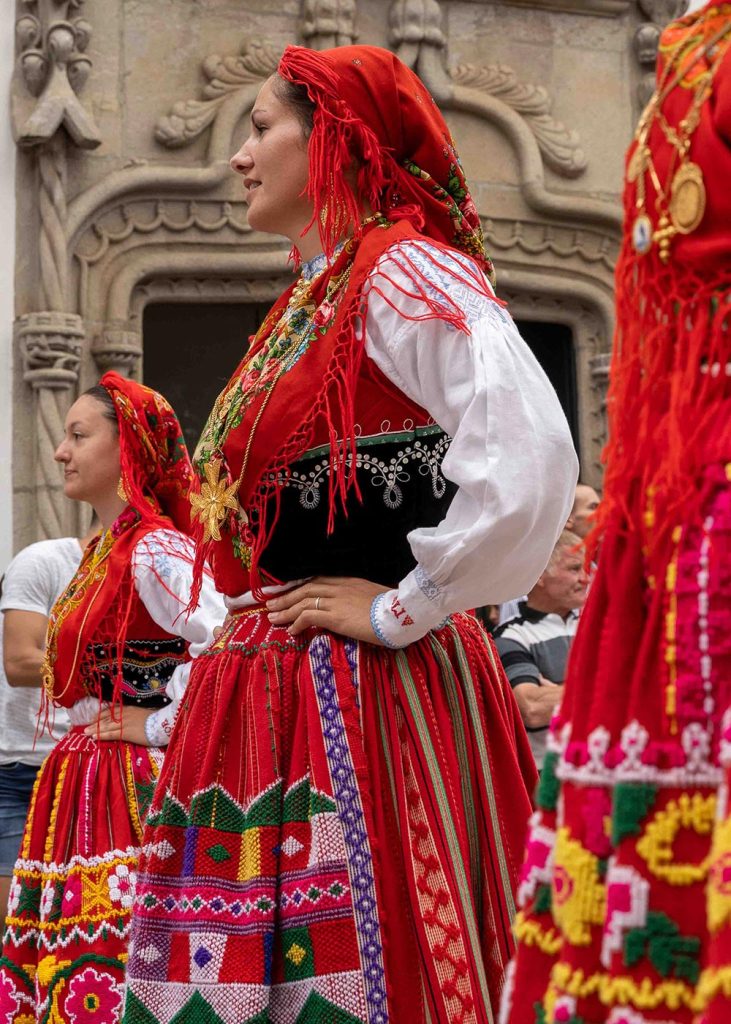
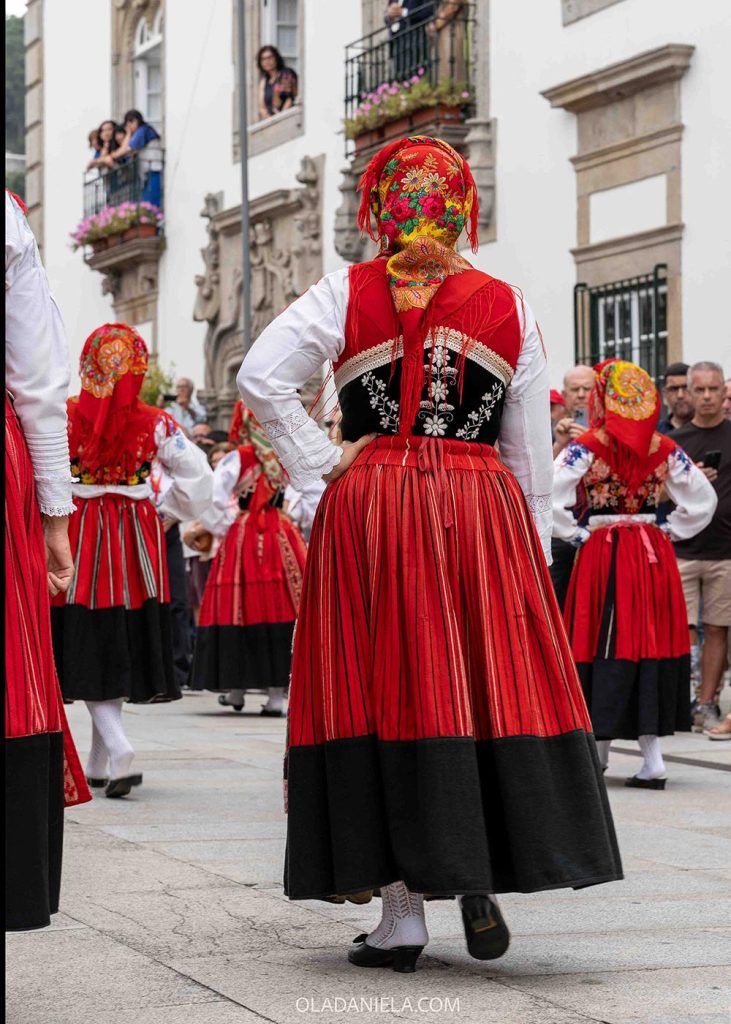

Read next: Romaria d’Agonia: The most beautiful traditional festival in Portugal
Trajes à Vianesa das Terras de Geraz (green costume)
While most of the traditional costumes in the parade are red, one region steps out in green. It’s the villages from around Terras de Geraz such as Geraz de Lima, who also don’t use a little side pocket. It’s thought the color came around after a royal visit from Dona Maria II in the early 19th century.
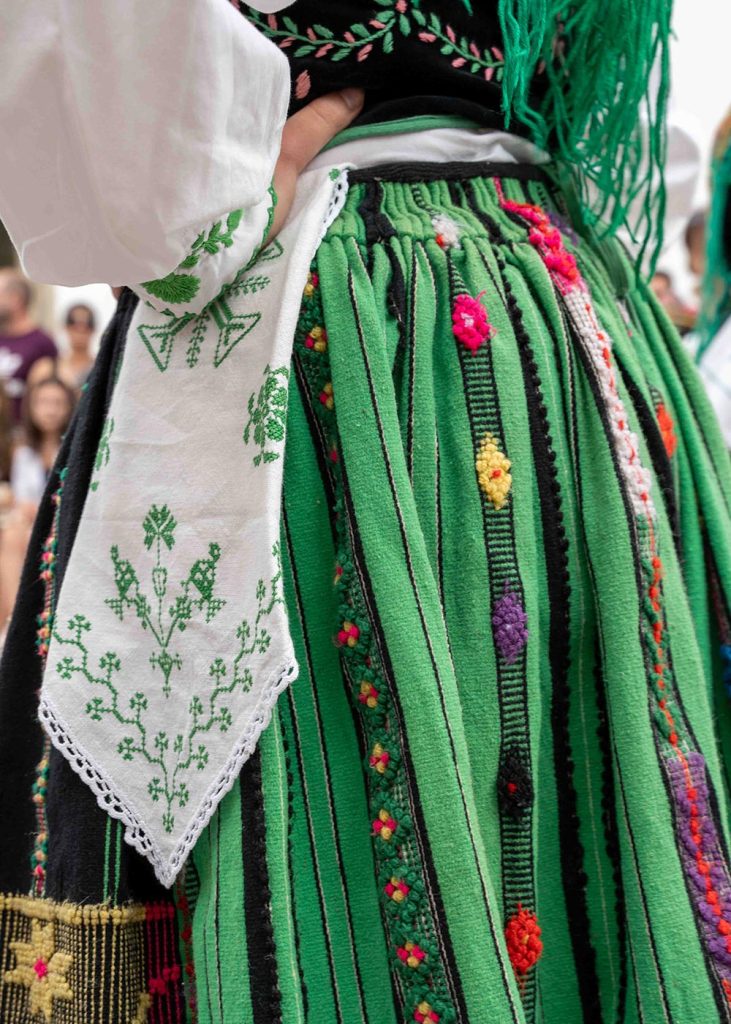
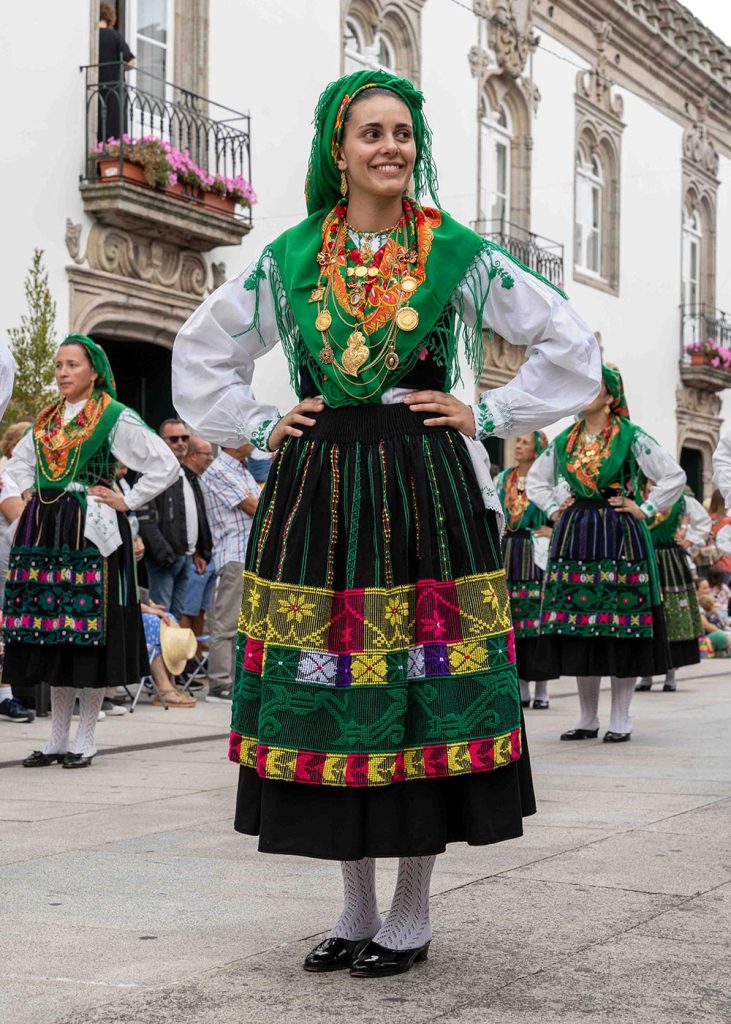
Trajes à Vianesa de Afife
The women from Afife mostly wear the red lavradeira costume, but distinguish themselves with a yellow headscarf and an orange scarf draped on the shoulders. Their red skirts have thin black and white vertical stripes with a red apron, shirts with white embroidery, and a red waistcoat.
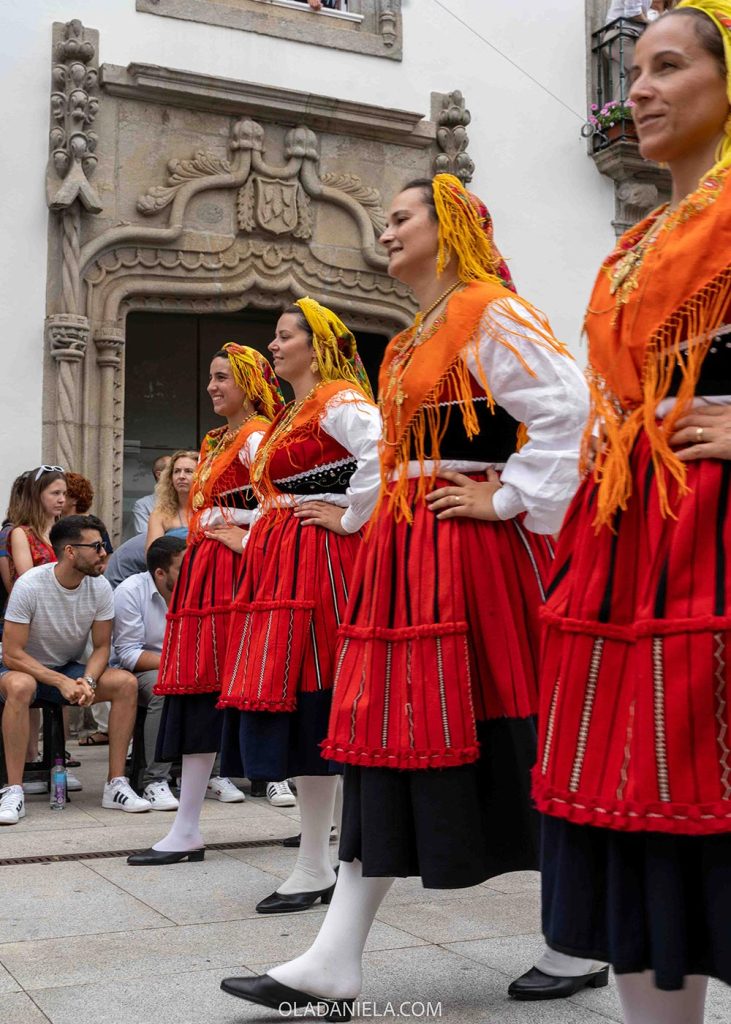
Trajes à Vianesa da Ribeira Lima
While there is a huge variety from village to village, this costume is generally characterised by striped skirts with a black bottom that is hand embroidered. It’s common to have floral aprons and shirts with blue embroidery.


Traje de Dó – Pity Costume
Yes, curiously enough when the lavradeira costume appears in dark colours – blacks, dark purple, deep blue – it’s the “traje de dó” which translates to pity dress. This one doesn’t seem to be specific to a certain region, and there are variations on it. It’s mostly a difference of colour, with a black skirt and apron with deep blues, greens, toasted yellow, and purples.
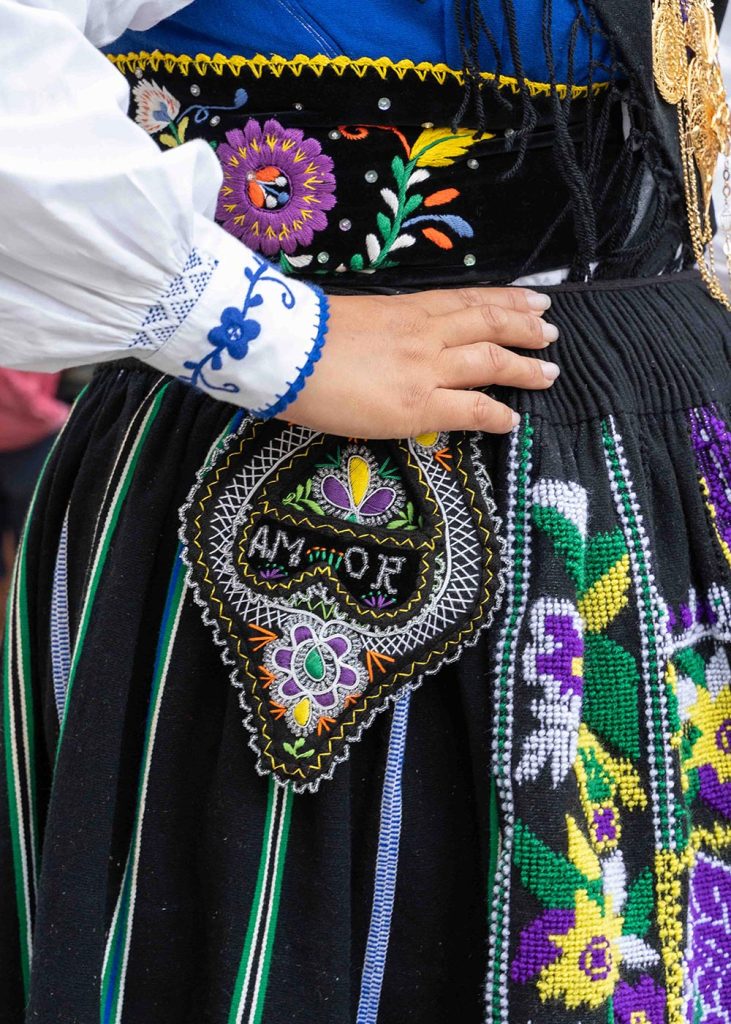
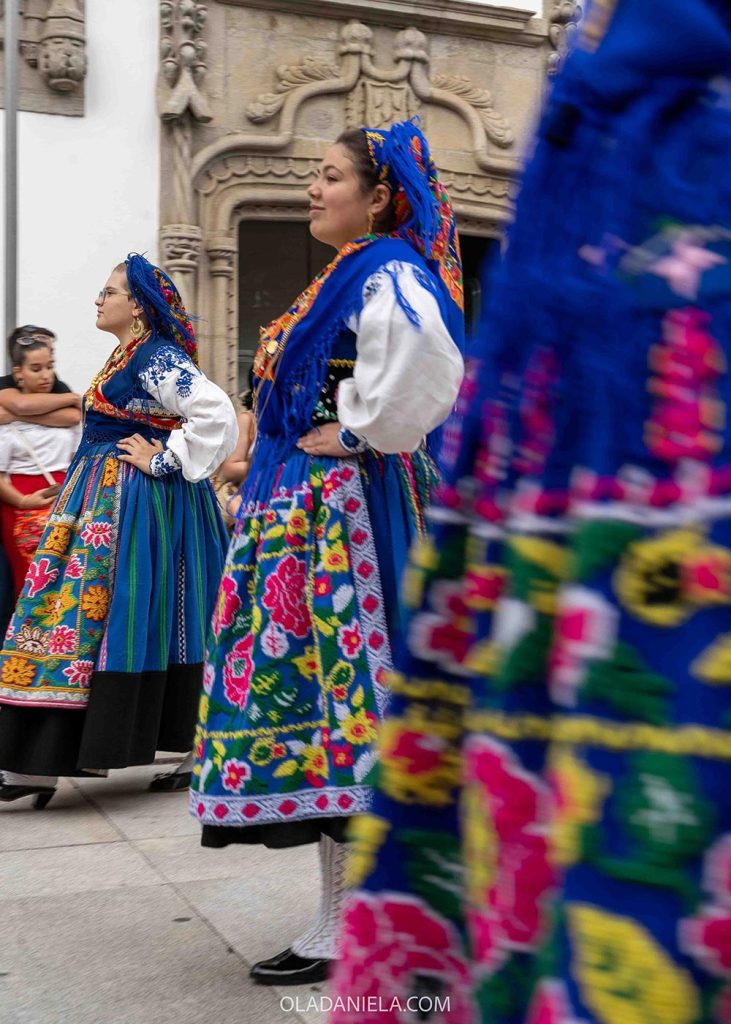
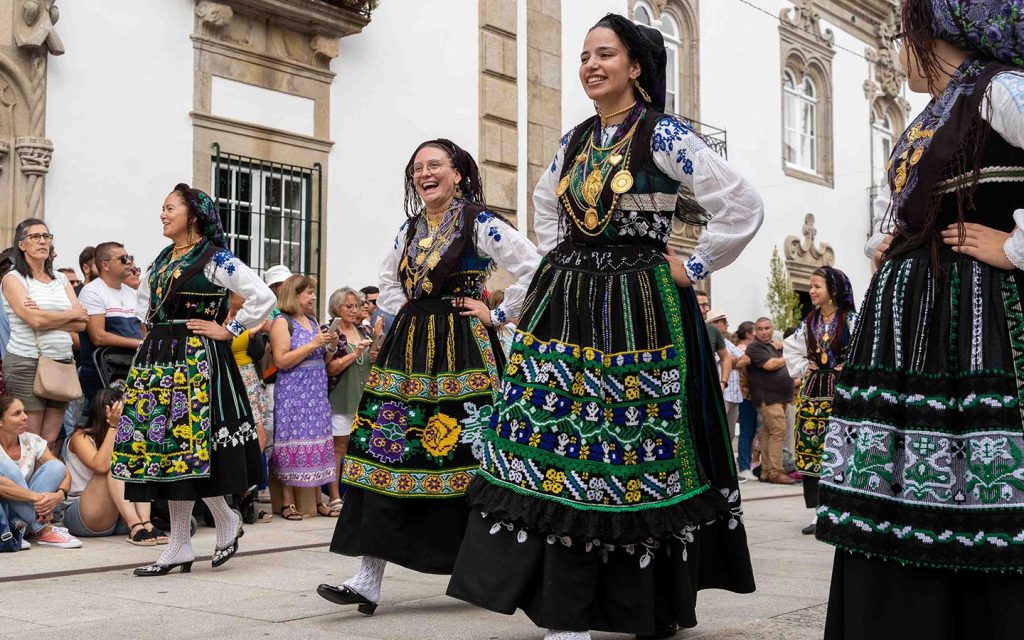
Trajes à Mordoma
The Mordomas were a young women chosen in each village to help raise funds for the church. They would help prepare for the festivities and pilgrimage, sweeping the churchyard and raising money for religious fairs. They would receive cash or goods – such as salted pork, rabbits, beans, corn, rye or linen, which would be auctioned off after Sunday mass.
For whatever reason, wearing this costume was mandatory so the girl (or her family) had to have the money to afford all the details of the dress. The traditional Mordoma dress includes a jacket or vest worn over an embroidered linen shirt. The jacket of vest is embroidered with glass beads and sequins.
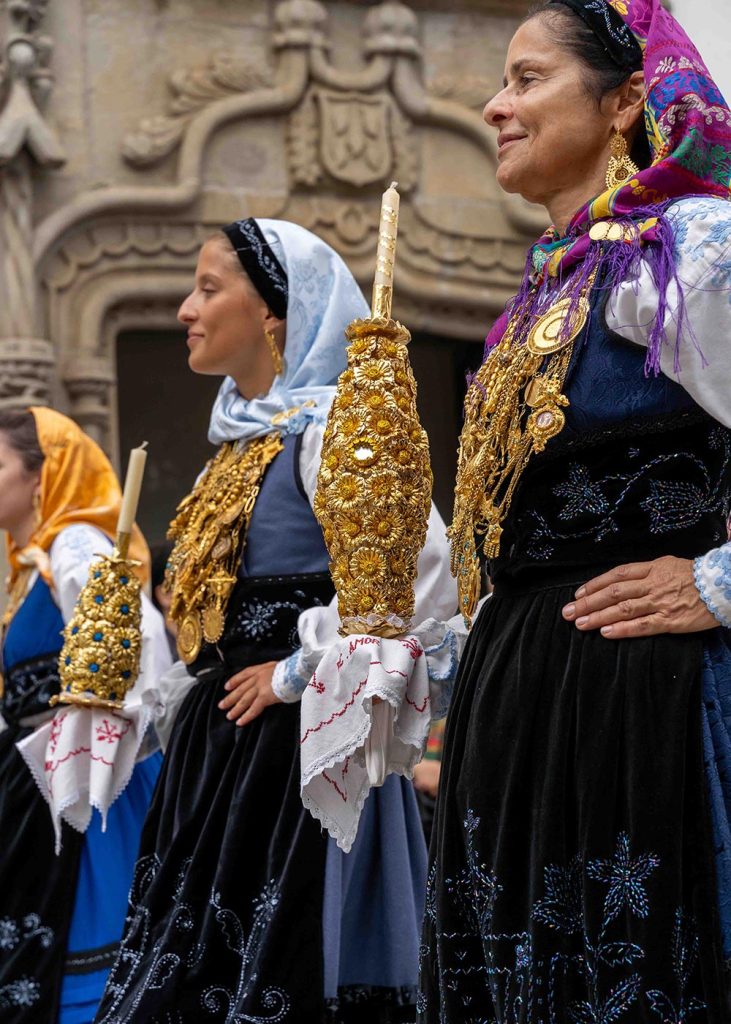

Apparently sometimes instead of black the costume could be a rich navy blue. Because the black dress doubled as a traditional wedding outfit, having this Mordoma costume in blue signaled that your family had the means to afford both. The difference between the Mordoma and the bride is the silk headscarf and the use of a palm or decorated candle instead of a veil and bouquet.
During the Romaria d’Agonia you’ll see the Mordomas in the ethnographic parade, the folk performances, and the Mordomia parade.
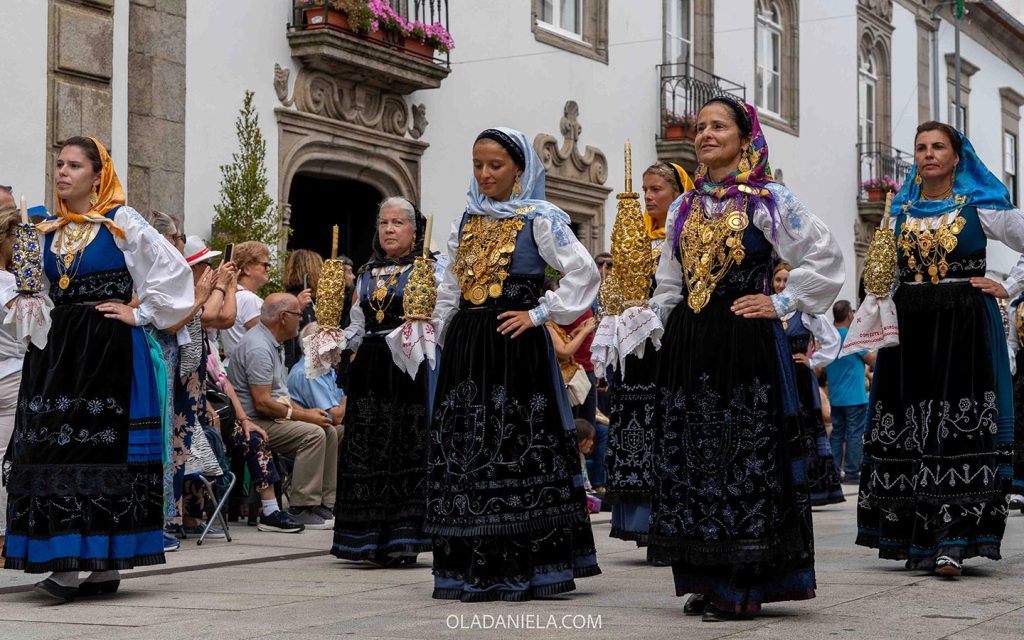
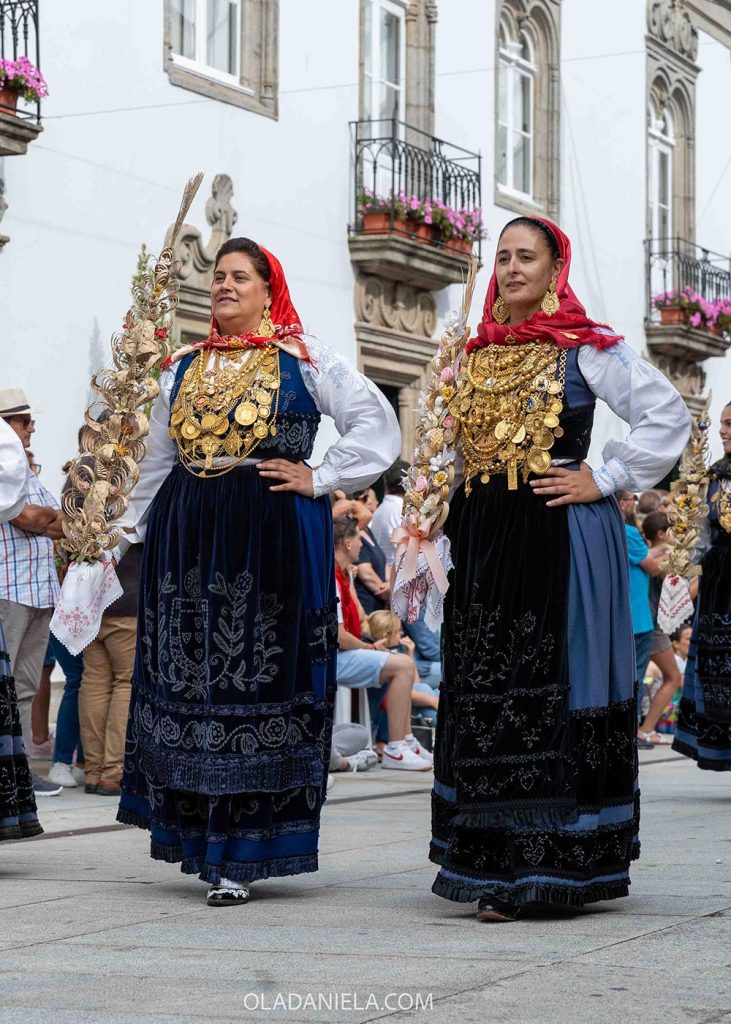

Traje À Noiva – Bride’s Costume
Curiously, the traditional wedding dress of the Minho region is just the Mordoma’s costume adapted for a bride’s wedding day. I read that from the end of the 19th-century until around 1905 that brides would wear a linen shirt with white embroidery and a black vest or waistcoat embroidered with glass beads.
The skirts sometimes had between seven and nine metres of cloth, with multiple underskirts and a woolen peticoat. The outer skirt was often velvet with glass beads sewn with silk thread, or decorated with silk ribbons embroidered with glass beads. Then there is a black apron with floral motifs and sometimes the Protuguese royal coat of arms in the centre.
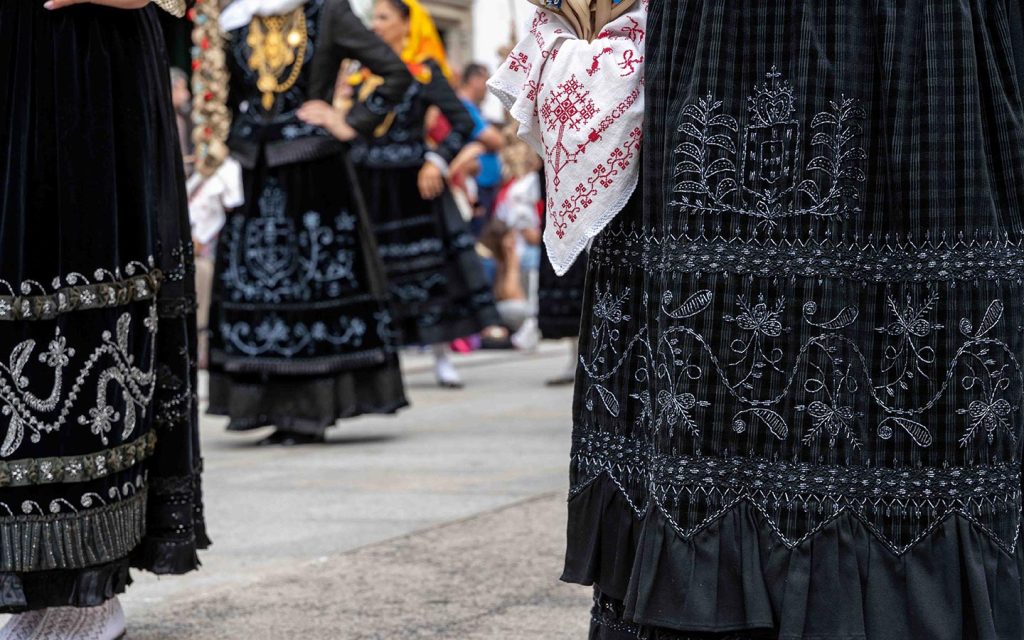
Brides also wore white cotton stockings with black leather mules, and a richly embroidered pockets that was tied at the waist known as an algibeira.
And, of course, brides wore an elaborately embroidered veil. The Mordoma costume is almost the same, and apparently some villages would have silk or muslin headscarves for brides too – something now only associated with the Mordoma.
You can see brides parading down the stress in the ethnographic parade, where the spectators yell “beijinhos” (kiss!), and at traditional costume show.
Trajes à Morgada – Heiress Costume
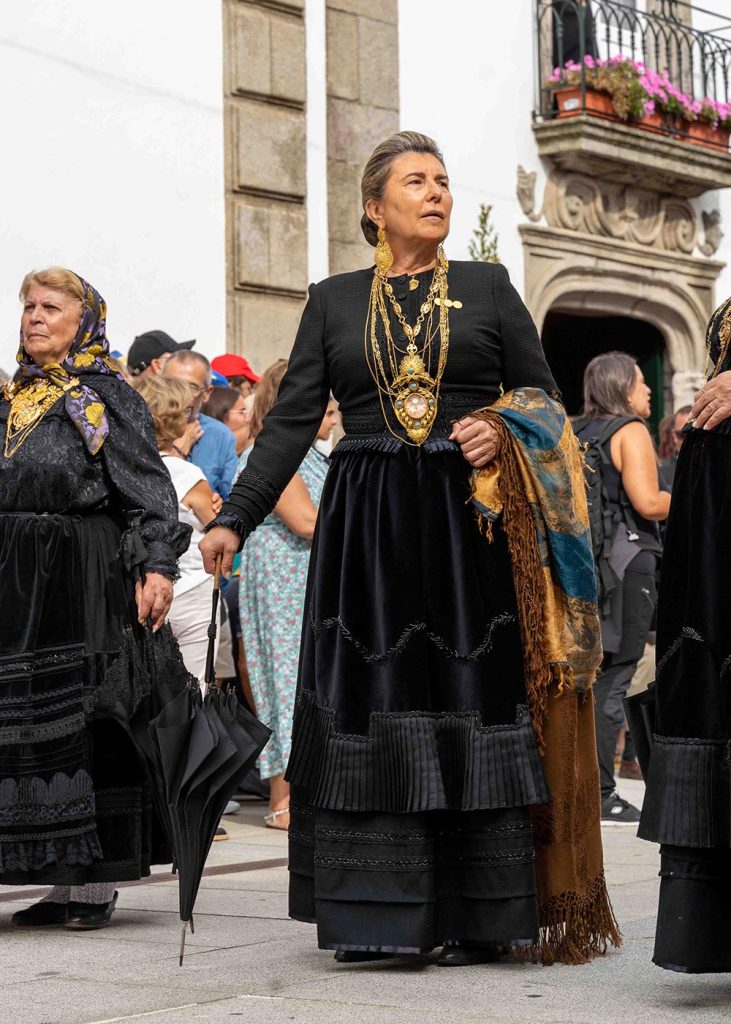

And finally, the Morgada. This costume I find a little confusing as it seems to be worn by elder women who would be the head of the household. The direct translation is heiress, so I guess you could say matriach of the house. I’ve also read it’s an outfit the eldest daughter would wear, who might be the heir is there is no male descendent. I’m working on getting some confirmation on this, but I wanted to publish this traje run down before the festival!
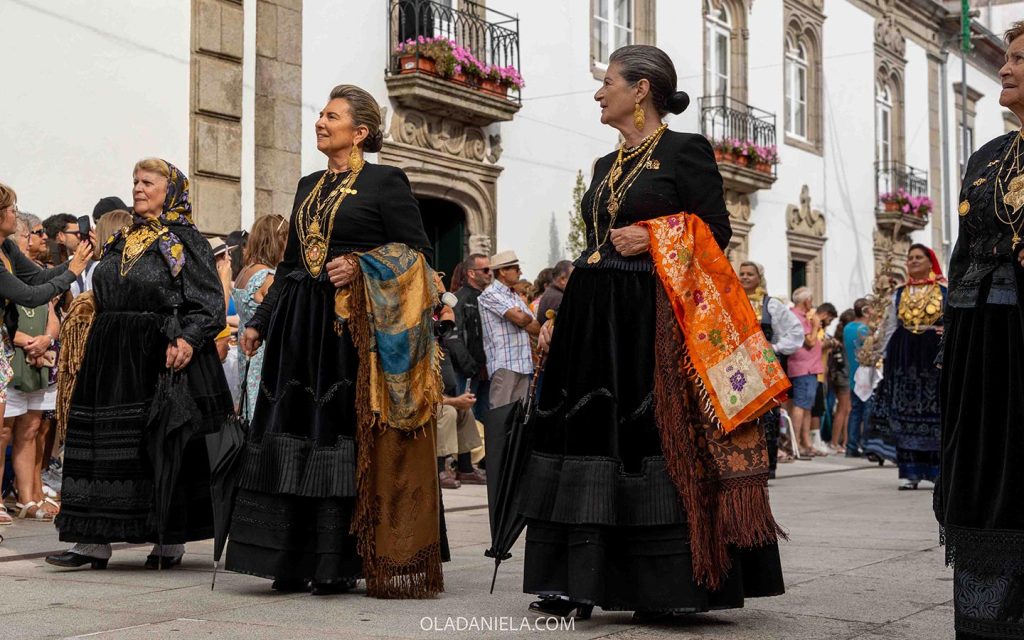
Whatever the reason behind the outfit, the Morgada traditional costume is less flashy than the Mordoma. It’s always black and lightly decorated, which makes the traditional gold filigree jewellery pop against the dark colour. This was a way to display their household’s economic power.
I noticed many women in the parade carried a richly patterned large silk shawl too.
The story and styles of Portuguese gold filigree jewellery
In the pictures you’ll see some women are dripping with gold. It’s said that girls would receive filigree gold pieces when they were born and for their birthdays or special occasions. Filigree gold balls, known as contas de Viana were commonly gifted, symbolising protection and good luck. It started with godmothers gifting girls these beads. One story I hear is that by the time a woman is ready to marry she would have had enough Viana beads to string on a necklace, the other is that a full strand is expensive so I woman would buy herself these beads one by one. I’m not sure if the Minho tradition from the 19th century is still as popular today, but I love both stories.

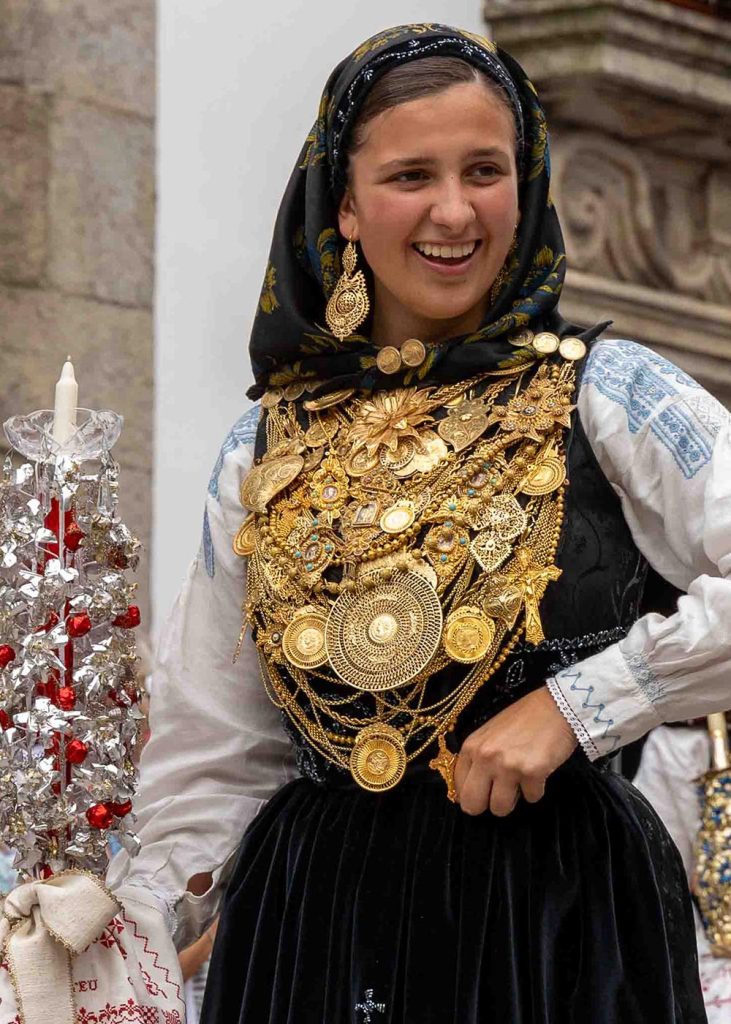
Filigree has existed on the Iberian Peninsula for thousands of years, but it really took hold in Portugal in the 17th century. Most traditional shapes represent religion, love and nature. Lots of women also wear the Heart of Viana, a wonky tear-drop-like heart. It was a symbol of dedicated to the Sacred Heart of Jesus, but now it more generally symbolises life, love, fraternity, and friendship. The heart would be gifted to brides for good luck, who would pass it on to their daughters.
You’ll also see a lot of religious crosses, and sometimes widows will have a tiny picture of their late husband. You might see filigree gold angels, flowers, fish, boats and religious figures. For earrings, you’ll see a style called arrecadas, and another called rainha or Queen earrings.
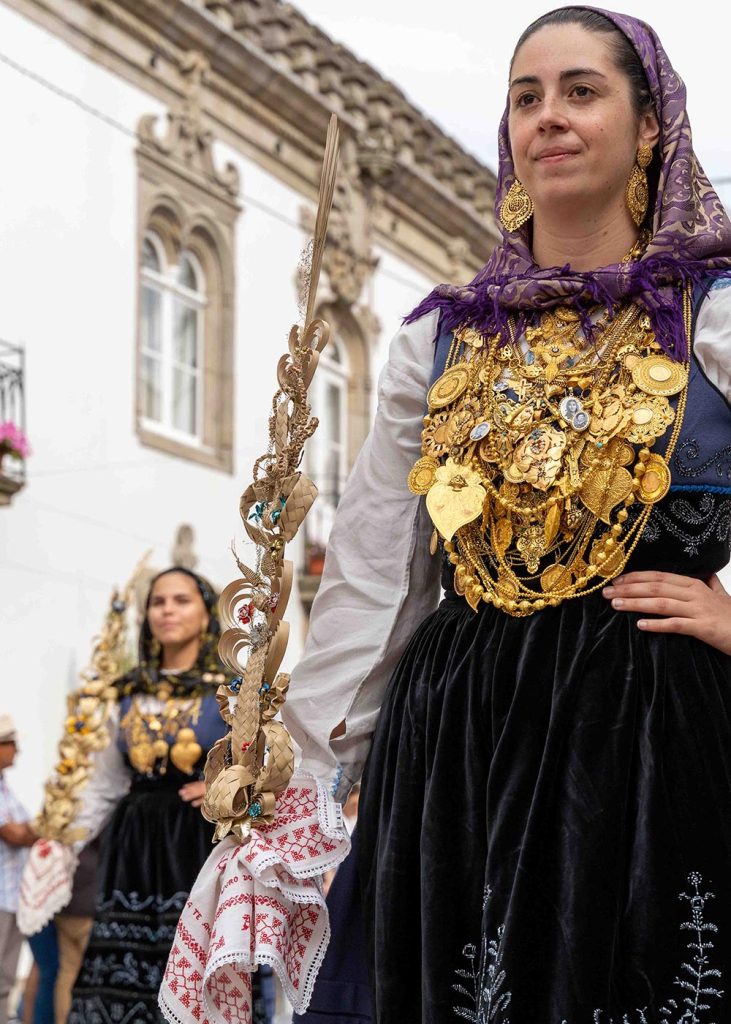
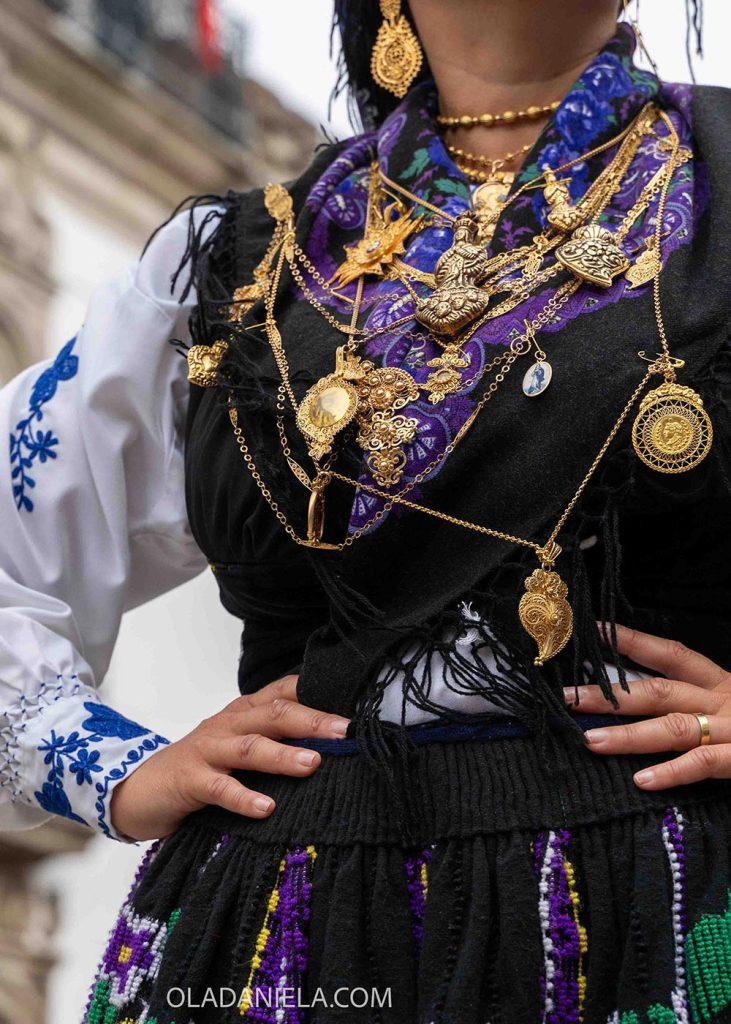

If you fall in love witt the gold filigree artform, you can find 19ct gold, silver and gold-plated silver filigree jewellery at any jeweller in Portugal. Naturally, there are plenty of jewellery stores in Viana do Castelo, but also in the big cities. Most of it is manufactured in the north around Gondomar and Póvoa do Lanhoso.
That’s my wrap of all the gorgeous traditional traje costumes in the Desfile de Mordomia, which is part of the Romaria d’Agonia – an amazing festival that falls each August.
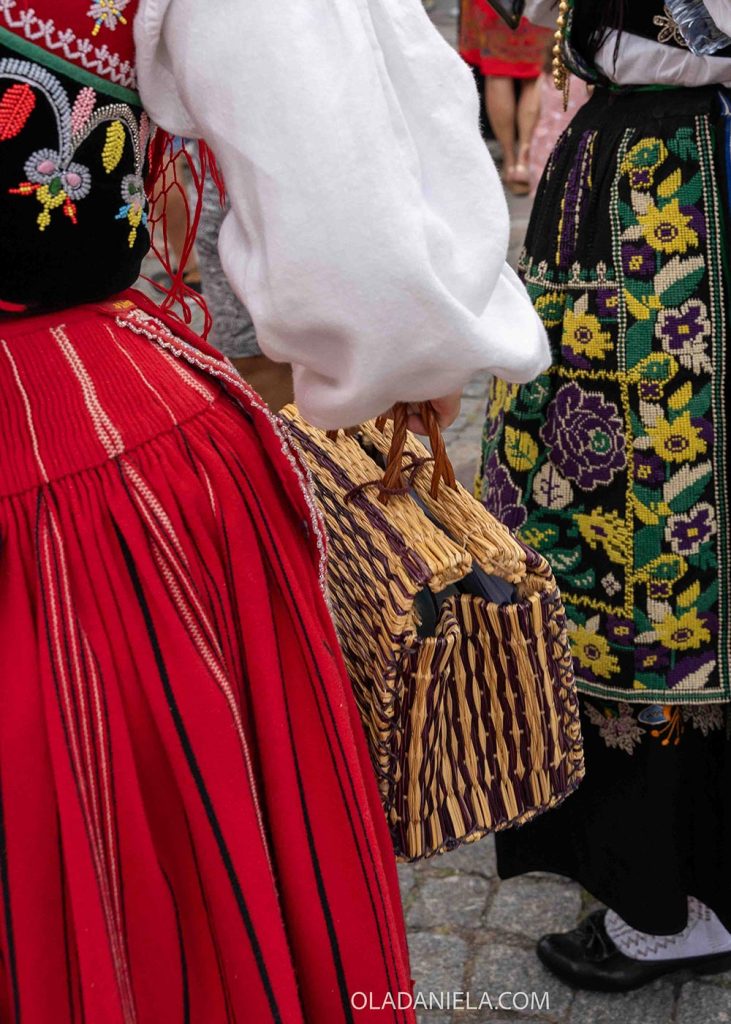
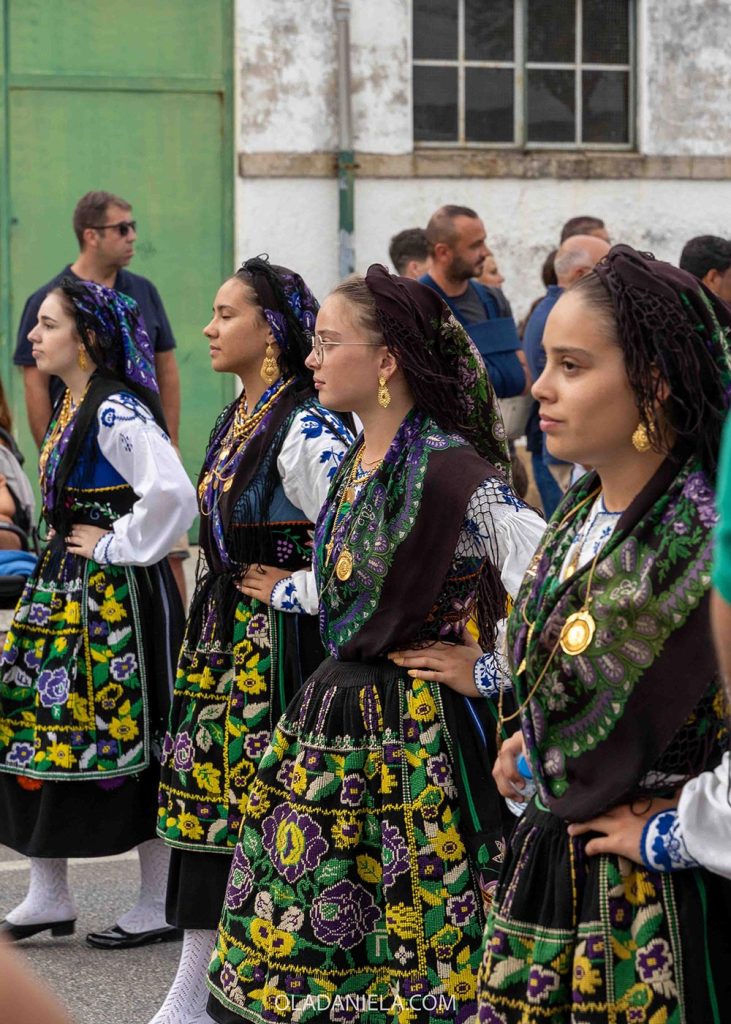
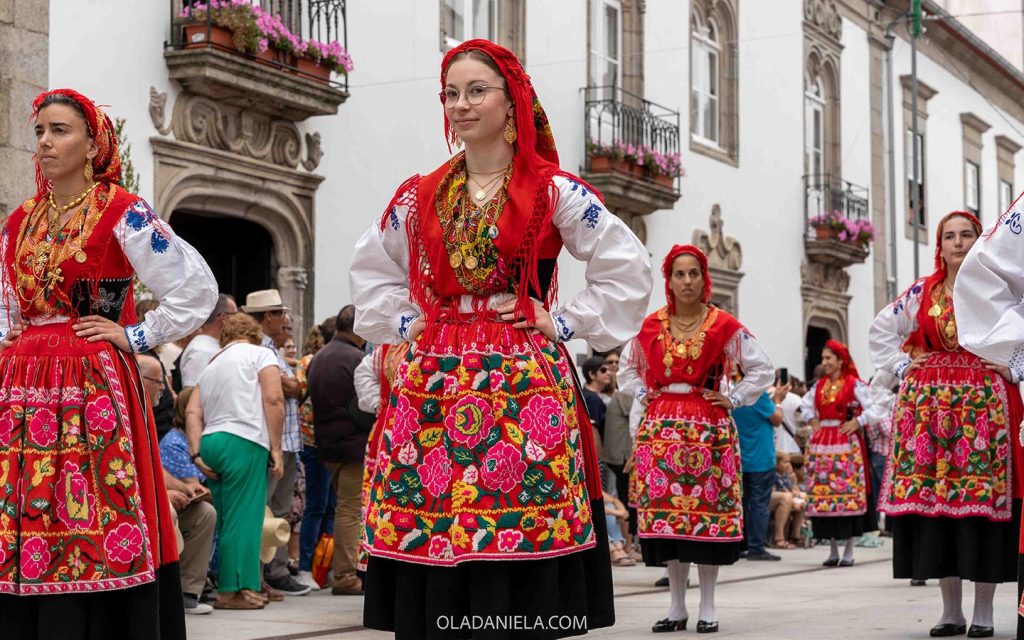

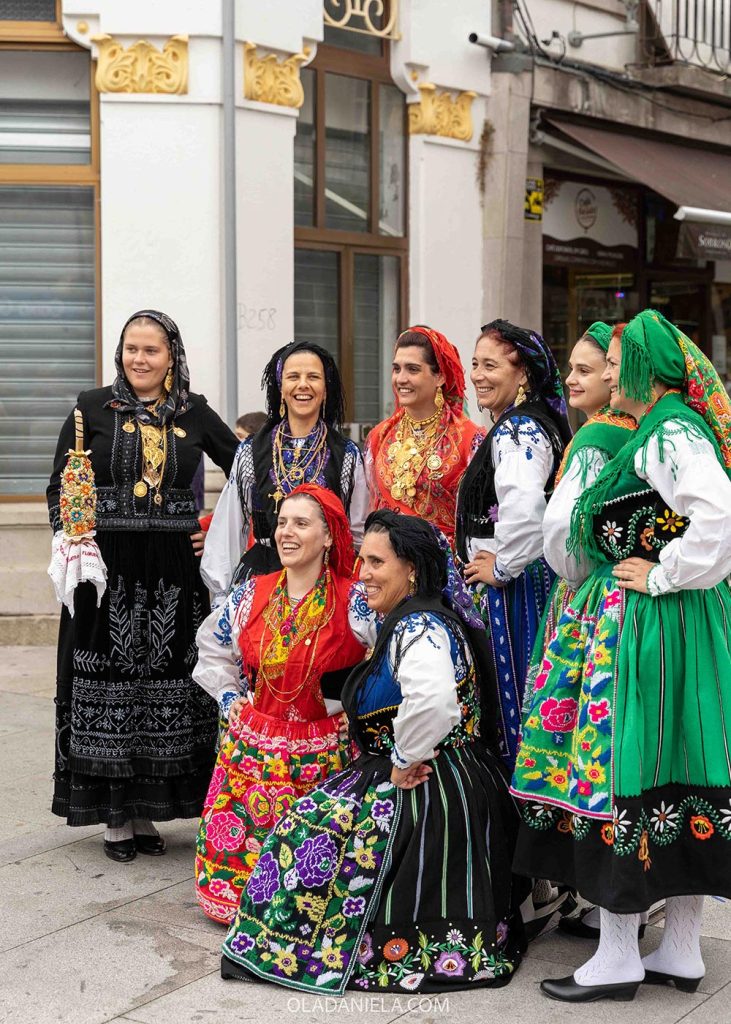
If you know more about some of the specific lavradeira costumes or have acorrection for me, leave a comment or reach out…
Keep reading…
- 15 best things to do in Viana do Castelo
- Romaria d’Agonia: The most beautiful traditional festival in Portugal
- Where to eat in Viana do Castelo
- Devil on the loose: 7 traditional pagan carnivals to attend in Portugal
- 19 best medieval and historic events in Portugal in 2024
- 36 hours in Coimbra
- 2024 Guide: Best Festivals & Events in Portugal
- Where to go vintage and second-hand shopping in Porto



